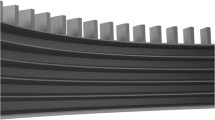Abstract
Minimizing unwanted leakage between stationary and rotating parts is the main function of annular seals. A Mixed labyrinth seal (MLS) with two specially designed lateral teeth installed on a Staggered labyrinth seal (SLS) is proposed to improve seal performance. A 3D computational fluid dynamics calculation model of MLS is set up. The twin vortex structure that appears in the seal cavity and flow path is more complicated in MLS than in SLS. MLS reduces leakage by about 30 % compared with SLS. Rotordynamic analysis of MLS is also conducted by calculating cross-coupled stiffness. The cross-coupled stiffness of MLS is about 75 % to 85 % that of SLS. The dependence of seal performance on the parameters of the lateral teeth is investigated through a simulation test. The lateral teeth should be set in the middle of the seal cavity, and the gap between the two lateral teeth should be similar to the tip clearance.
Similar content being viewed by others
References
H. L. Stocker, Advanced labyrinth seal design performance for high pressure ratio gas turbines, ASME 1975 Winter Annual Meeting, Houston, Texas, USA, 30 November -5 December 1975, paper no. 75-WA/GT-22, pp. V001T01A005. New York: ASME.
R. Gao and G. Kirk, CFD study on stepped and drum balance labyrinth seal, Tribol. Trans., 56 (4) (2013) 663–671.
R. Gao, Computational fluid dynamic and rotordynamic study on the labyrinth seals, Ph.D. Thesis, Virginia Polytechnic Institute and State University, USA(2012).
W. Z. Wang et al., Numerical analysis of leakage flow through two labyrinth seals, J. Hydrodyn, Ser. B, 19 (1) (2007) 107–112.
D. L. Rhode, J. W. Johnson and D. H. Broussard, Flow visualization and leakage measurements of stepped labyrinth seals: part 1—annular groove, J. Turbomach, 119 (4) (1997) 839–843.
D. L. Rhode, S. H. Ko and G. L. Morrison, Experimental and numerical assessment of an advanced labyrinth seal, Tribol. Trans., 37 (4) (1994) 743–750.
S. P. Asok et al., Neural network and CFD-based optimisation of square cavity and curved cavity static labyrinth seals, Tribol. Int., 40 (7) (2007) 1204–1216.
J. M. Vance and J. M. Li, Test results of a new damper seal for vibration reduction in turbomachinery, J. Eng. Gas Turbines Power, 118 (4) (1996) 843–846.
A. M. G. Eldin, Leakage and rotordynamic effects of pocket damper seals and see-through labyrinth seals, Ph.D. Thesis, Texas A&M University, USA(2007).
G. Kirk and R. Gao, Influence of preswirl on rotordynamic characteristics of labyrinth seals, Tribol. Trans., 55 (3) (2012) 357–364.
Z. G. Li, J. Li and Z. P. Feng, Numerical comparison of rotordynamic characteristics for a fully partitioned pocket damper seal and a labyrinth seal with high positive and negative inlet preswirl, J. Eng. Gas Turbines Power, 138 (4) (2015) 042505–042505-13.
E. A. Baskharone, Swirl brake effect on the rotordynamic stability of a shrouded impeller, J. Turbomach., 121 (1) (1999) 127–133.
D. W. Childs et al., Rotordynamic performance of a negative-swirl brake for a tooth-on-stator labyrinth seal, J. Eng. Gas Turbines Power, 138 (6) (2015) 062505–062505-8.
E. A. Soto and D. W. Childs, Experimental rotordynamic coefficient results for: (a) a labyrinth seal with and without shunt injection and (b) a honeycomb seal, J. Eng. Gas Turbines Power, 121 (1) (1999) 153–159.
H. L. Stoker, D. M. Cox and G. F. Holle, Aerodynamic performance of conventional and advanced design labyrinth seals with solid-smooth, abradable and honeycomb lands, NASA Technical Report, Report no. NASA-CR-135307, 21 Jul 1976-21 Nov(1977).
Z. G. Li, J. Li and Z. P. Feng, Numerical investigations on the leakage and rotordynamic characteristics of pocket damper seals-part II: effects of partition wall type, partition wall number, and cavity depth, J. Eng. Gas Turbines Power, 137 (3) (2014) 032504–032504-13.
W. J. Kearton and T. H. Keh, Leakage of air through labyrinth glands of staggered type, Proc. IMechE, Part A: J. Power and Energy, 166 (1952) 180–195.
T. Hirano, Z. L. Guo and R. G. Kirk, Application of computational fluid dynamics analysis for rotating machinery— part II: labyrinth seal analysis, J. Eng. Gas Turbines Power, 127 (4) (2005) 820–826.
A. O. Pugachev, U. Kleinhans and M. Gaszner, Prediction of rotordynamic coefficients for short labyrinth gas seals using computational fluid dynamics, J. Eng. Gas Turbines Power, 134 (6) (2012) 062501–062501-10.
S. H. Kim and T. W. Ha, Prediction of leakage and rotordynamic coefficients for the circumferential-groove-pumb seal using CFD analysis, Journal of Mechanical Science and Technology, 30 (5) (2016) 2037–2043.
Z. R. Li et al., Investigation and improvement of the staggered labyrinth seal, Chin. J. Mech. Eng-En., 28 (2) (2015) 402–408.
S. Subramanian, A. S. Sekhar and B. V. S. S. S. Prasad, Influence of combined radial location and growth on the leakage performance of a rotating labyrinth gas turbine seal, Journal of Mechanical Science and Technology, 29 (6) (2015) 2535–2545.
Author information
Authors and Affiliations
Corresponding author
Additional information
Recommended by Associate Editor Sangyoup Lee
Mingjie Zhang is studying for his Master’s degree in engineering science in the Department of Power Engineering, Southeast University. His research interests include rotordynamics and flow-induced vibration in turbomachinery.
Jiangang Yang received his Ph.D. from the Department of Power Engineering, Southeast University, in 1995 and is the Deputy Director of National Engineering Research Center of Turbo-generator Vibration. His research areas include rotating machinery fault monitoring and diagnosis, rotordynamics, and flowinduced vibration.
Rights and permissions
About this article
Cite this article
Zhang, M., Yang, J., Xu, W. et al. Leakage and rotordynamic performance of a mixed labyrinth seal compared with that of a staggered labyrinth seal. J Mech Sci Technol 31, 2261–2277 (2017). https://doi.org/10.1007/s12206-017-0423-7
Received:
Revised:
Accepted:
Published:
Issue Date:
DOI: https://doi.org/10.1007/s12206-017-0423-7



